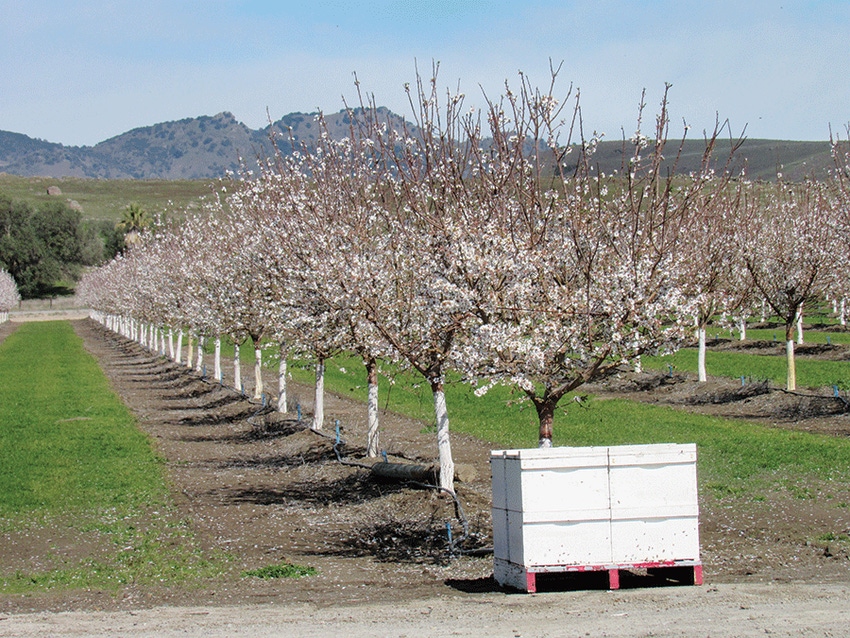
With almond bloom under way in most orchards, bees have been moved into strategic locations and pollination is underway.
As every grower will tell you, pollination is paramount for a successful almond crop. If the busy bees fail to do their job, there’s no hope for a good crop in the orchard. Ensuring that the honey bees in your orchard are healthy is critical for the long-term health of the almond industry, which means taking care of the pollinators — and bee safety in general — become a priority each year in the winter-spring season.
Research from Blue Diamond officials indicates beekeepers have been active in orchards up and down the valleys of central California, moving colonies into orchards in preparation for bloom. As of this report, bloom is at or near peak in most areas and honey bees are active in orchards throughout the Valley.
According to the Almond Board of California, almonds are one of some 90 foods that rely on bee pollination to survive. While there is worldwide awareness of the risk to bee populations in modern times, almond producers have been leading the way in researching and implementing pollinator protection. The need for more honey bees has been increasing in the almond industry, and preserving the health and welfare of these pollinators is a year-round effort by California growers.
By now orchard operators have communicated with their neighbors, and a ban on all chemical applications has been implemented, with the exception of certain required fungicides, and even then, rigid rules apply before those materials are used.
“Everyone should know to avoid insecticides when honey bee colonies are in the orchard,” University of California Cooperative Extension Integrated Pest Management Advisor Emily Symmes says. “There are also alternative and equally effective timing(s) for managing peach twig borer under different circumstances.”
According to the Almond Board’s general guidelines on pollinator safety, “If it is necessary to spray the orchard with fungicides, do so in the late afternoon or evening when bees and pollen are not present. Avoid tank-mixing products during bloom until more is known in this area.”
BEES’ MIDDAY WORK
Pollen is released in the morning when temperatures reach 55 degrees (F), and is often removed by foraging honey bees by midafternoon. The “bee safest” time to apply fungicides is in the evening or at night when temperatures are less than 55 degrees.
“Never spray hives or bees directly with any material,” Symmes says. “Contaminated foraging worker bees will carry the fungicide back to the hive, where other worker bees will clean them and contaminate the hive’s food supply. Aside from these toxicity concerns, bee flight ability can be impacted from the weight of any spray droplets, even water, which can cause pollen grains to burst, affecting pollination.”
The ABC also warns that insecticide use should be avoided during bloom. Fortunately, there are several insecticide application timing options available beyond bloom-time treatments, it advises.
Neighboring farms should have already been notified of your pollination plans, and the introduction of bees into your orchard. If you communicated properly, nearby farms should be aware that you are requesting 48-hour advance notice of when that farm will be spraying insecticides and which chemicals are being used.
In recent years, better cooperation has been reported between almond operations and neighboring farms, and the result has been more effective safety for honey bee health. Crop management programs such as Agrian or CDMS are being more extensively used in California, communication between farmers in close proximity to almond orchards has been better in coordinating with county agricultural officials and extension agents concerning pollinator safety.
CLEAN WATER IMPORTANT
To effectively protect bee colonies, growers should avoid overlooking the need for clean, potable water. Water in ponds and even irrigation streams may have been contaminated by insecticides, especially those located outside the orchard and within a mile of almond operations.
Clean water should be readily available for bees. This also helps in the pollination process, as bees find water readily available instead of having to travel for it. Make certain a responsible individual is tasked with maintaining the clean water supply for the visiting honey bees.
In California there are strict state rules and guidelines for pollinator health and safety, including registration and reporting of safety incidents. Almond growers should be aware of these guidelines and keep up with the latest requirements, as well as reporting mishaps and accidents in a timely manner.
Bee safety is the responsibility of all active farmers, and educating your staff and neighbors is the best way to foster cooperation and promote bee protection, especially through the end of the pollination season.
About the Author(s)
You May Also Like






